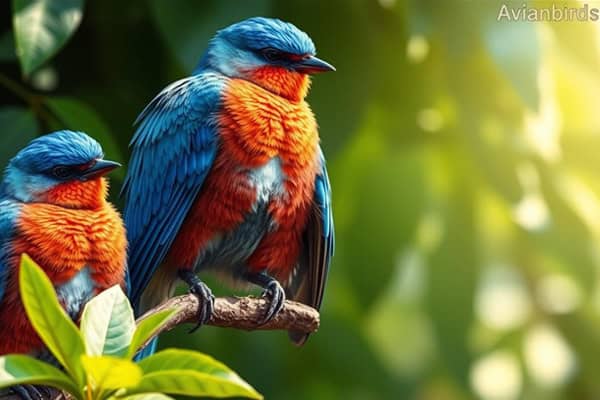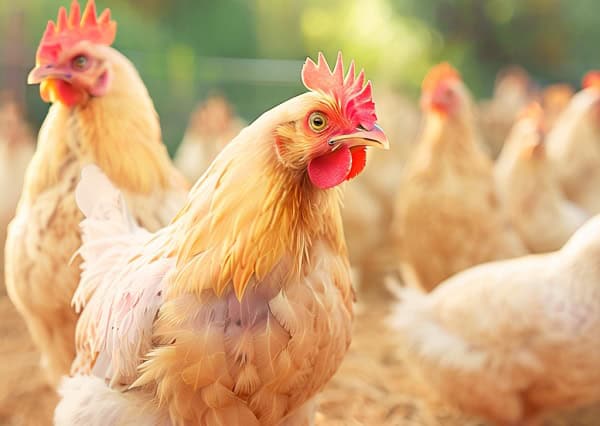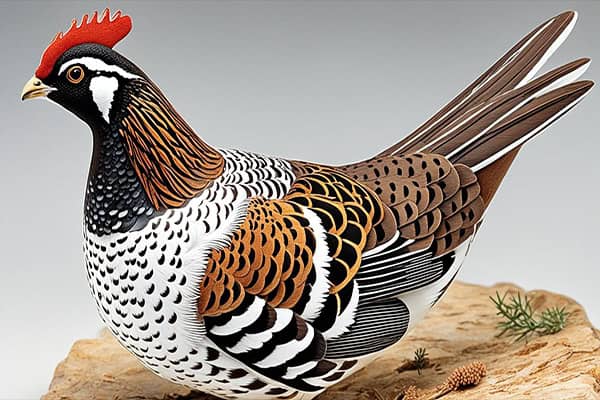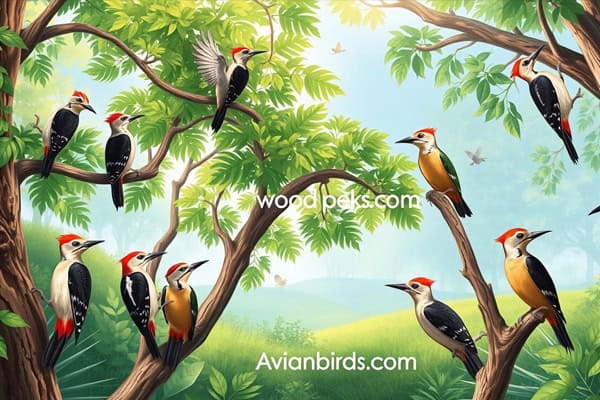Blue Bird With A Red or Orange Chest: Colorful Avian
Ever seen a blue bird with a bright red-orange chest and wondered what it was? We’re diving into the world of the Blue Bird With Red Orange Chest. We’ll focus on the Eastern Bluebird (Sialia sialis) and Western Bluebird (Sialia mexicana). These birds are often seen in open fields, sitting on fence posts or wires.
We’ll explore what makes these birds special. You’ll learn how to tell them apart and spot them in the wild. Come along as we discover the vibrant details of these birds and where to find them.
Blue Bird With Red Orange Chest
The eastern bluebird, known as Sialia sialis, is a favorite among birdwatchers in North America. It has a bright red-orange chest and blue feathers. First described by Carl Linnaeus in 1758, it belongs to a family with seven subspecies. Knowing how to spot and understand these birds makes birdwatching more fun, especially in areas from southern Canada to the Gulf states.
Eastern bluebirds are 16 to 21 cm long and have wings up to 32 cm wide. Watching them shows their beauty and how they adapt. Their diet changes with the seasons, affecting how they hunt and eat, similar to how birds with orange chests adapt their feeding habits. Learning about their behavior helps us enjoy nature more and see their importance in the ecosystem.
| Characteristic | Details |
|---|---|
| Scientific Name | Sialia sialis |
| Length | 16–21 cm (6.3–8.3 in) |
| Wingspan | 25–32 cm (9.8–12.6 in) |
| Weight | 27–34 g (0.95–1.20 oz) |
| Eggs per Clutch | 3–7 light-blue or white |
| Population Trend | Greater than 1.5% annual increase (1966–2015) |
| Lifespan | 6 to 10 years |
Learning about the eastern bluebird’s traits and habits deepens our connection with nature. These birds live in different places, from old fields to orchards. By watching and learning, we can all enjoy their beauty and importance.
The Colorful Plumage of Blue Birds
Exploring blue birds reveals their stunning plumage. This beauty captivates both bird lovers and casual viewers. The way we see their colors changes with the light, making their plumage even more special.
The Impact of Lighting on Bird Color Perception
Birds see colors differently than we do. Their feathers have special structures that change how light is seen. For instance, the male Eastern Bluebird’s feathers reflect sunlight, showing a bright blue that looks different in dim light.
This shows how hard it can be to judge a bird’s beauty and type. It’s not just about the colors they show us.
Understanding Blue as a Color in Birds
Blue in birds is not from a pigment. It comes from the tiny structures in their feathers. These structures bend light, creating the blue we see.
Male Eastern Bluebirds have bright blue feathers and red chests. Their colors are not just for looks. They help in finding a mate and defending their territory, which is crucial for the survival of birds with orange chests. Knowing this makes us appreciate their colors and how they live.
1. Belted Kingfisher
- Scientific Name: Megaceryle alcyon
- Size: 28–35 cm (11–14 in) in length
- Weight: 100–150 g (3.5–5.3 oz)
- Lifespan: 6–7 years on average
- Diet: Fish, crustaceans, and aquatic insects
The belted kingfisher lives near lots of water, like rivers and lakes. It’s easy to spot because of its bright blue and rufous feathers. These colors help it blend in and stand out in nature.
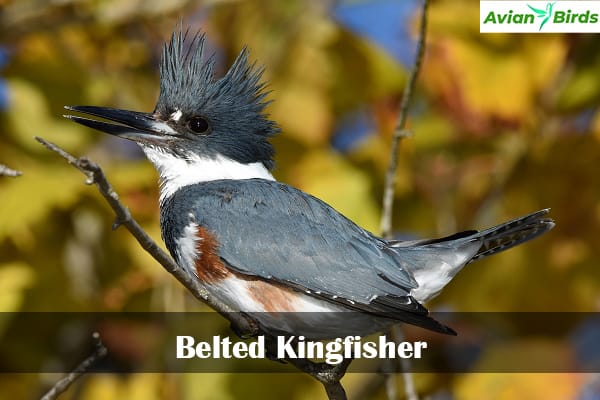
When it hunts for fish, its sharp eyesight lets it dive into the water with grace. Watching them is a treat during outdoor adventures.
2. Barn Swallow
- Scientific Name: Hirundo rustica
- Size: 14–19 cm (5.5–7.5 in) in length
- Weight: 11–20 g (0.39–0.71 oz)
- Lifespan: 4–5 years on average
- Diet: Insects, primarily flying insects
The barn swallow is often seen flying over fields and near water. Its blue back and tan chest make it a beautiful sight in the sky. It’s known for its agility in the air, flying fast and smoothly.

Watching it chase after insects is a joy. Its flying skills are impressive.
3. Red-Breasted Nuthatch
- Scientific Name: Sitta canadensis
- Size: 11–12 cm (4.3–4.7 in) in length
- Weight: 11–20 g (0.39–0.71 oz)
- Lifespan: 2–3 years on average
- Diet: Insects, seeds, and nuts
The red-breasted nuthatch lives in forests with lots of trees. It has a blue-gray back and a bright red chest. This little bird is full of character.
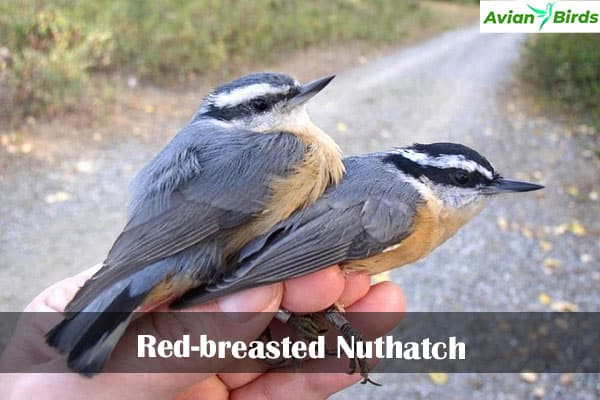
Its call is unique, and it climbs trees upside down. These traits make it interesting to watch.
4. Western Bluebird
- Scientific Name: Sialia mexicana
- Size: 16–19 cm (6.3–7.5 in) in length
- Weight: 25–30 g (0.88–1.06 oz)
- Lifespan: 6–10 years on average
- Diet: Insects, fruits, and berries
The Western Bluebird is a fascinating bird known for its unique traits and striking appearance. Its characteristics give us insights into its behavior and ecology. This bird has physical features, habitat preferences, and feeding behavior that make it stand out.
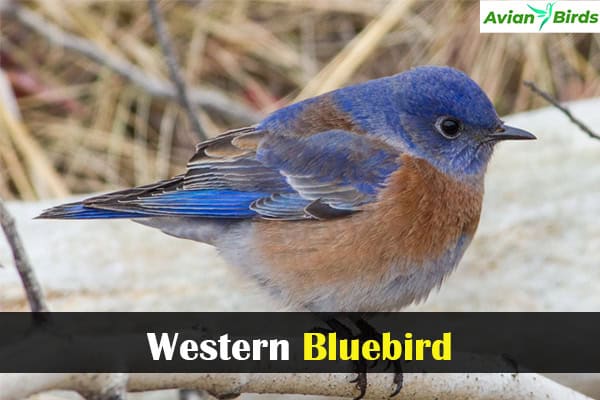
Habitat Preferences and Range
Western Bluebirds live in various environments, showing different habitat preferences. They like open woodlands, farmland, backyards, and even burned areas. These places offer them plenty of food to find.
They can live from sea level up to mountainous regions. The species is called Sialia mexicana and is not considered endangered. With six subspecies, each has its own unique traits, adding to biodiversity.
Feeding Habits and Behavior
Understanding how Western Bluebirds eat is key to knowing them. They mainly eat insects and berries, much like the eastern north robin. They hunt insects by dropping from trees to the ground.
They also eat berries from trees, especially in autumn. Western Bluebirds are social birds, often seen together. This helps them find food more efficiently. They communicate by singing, with males singing to attract mates and mark their territory, especially in eastern North America.
| Characteristic | Details |
|---|---|
| Size | 15 to 18 cm (5.9 to 7.1 in) |
| Adult Male Coloration | Bright blue above with a rust-orange breast |
| Female Coloration | Gray-buff with blue tints, pale orange wash |
| Nesting Behavior | Nests in cavities or boxes, competes for sites |
| Diet | Insects and berries |
| Social Behavior | Feeds in flocks, significant social structure |
5. Easter Bluebird
- Scientific Name: Sialia sialis
- Size: 16–21 cm (6.3–8.3 in) in length
- Weight: 28–32 g (0.99–1.13 oz)
- Lifespan: 6–10 years on average
- Diet: Insects, fruits, and berries
The Eastern Bluebird is known for its stunning traits. It has bright blue upperparts and an orange chest. The white belly adds a striking contrast. Males are more brightly colored than females, with slightly duller looks.

These birds are six to eight inches long and live in open areas like meadows. They perch on low branches or fences to find insects and spiders. In the fall and winter, they eat wild fruits and berries.
Eastern Bluebirds nest in cavities made by woodpeckers. They lay oval eggs that are light blue, sometimes white. The eggs incubate for 13 to 14 days, longer in cold weather.
Eastern Bluebirds once had fewer numbers due to urbanization and invasive species. However, people who built bluebird houses helped their numbers grow, improving their behavior and nesting success.
| Feature | Details |
|---|---|
| Length | 6 to 8 inches |
| Coloration | Blue upperparts, orange chest, and striking wings and tail make the Western Bluebird easily identifiable. |
| Nesting | Secondary cavity nester, relies on woodpeckers |
| Egg Color | Light blue (occasionally white) feathers can be seen in both bluebirds and some small thrush species. |
| Incubation Duration | 13 to 14 days |
| Feeding Behavior | Insects and spiders in breeding season; fruits and berries in fall/winter |
| Population Recovery | Stable or increasing in recent years due to conservation efforts |
6. Lazuli Bunting
- Scientific Name: Passerina amoena
- Size: 12–14 cm (4.7–5.5 in) in length
- Weight: 11–20 g (0.39–0.71 oz)
- Lifespan: 2–3 years on average
- Diet: Seeds, berries, and insects
The lazuli-bunting Blue Bird With A Red or Orange Chest is another beautiful bird with bright blue feathers and a catchy song. It lives in brushy areas, often near water. Its unique feathers stand out against the natural scenery.
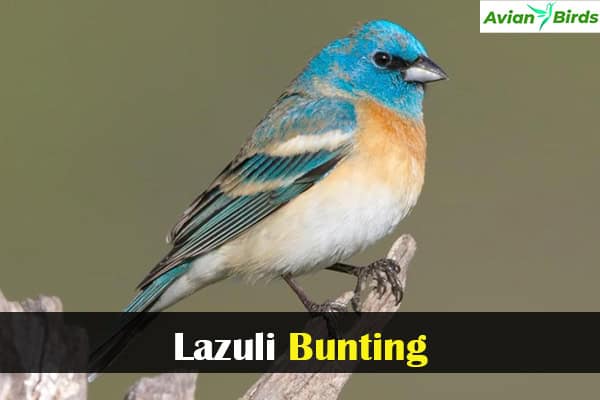
Related Video about Blue Bird With A Red or Orange Chest:
Identifying the Blue Bird With Red Orange Chest
We’re investigating how to distinguish Eastern Bluebirds from Western Bluebirds. We’ll focus on their physical traits and behavior, which will help us improve our bird-spotting skills. The bright colors and where they live are key to telling them apart. Do you know Bluebirds are found in other regions? If you read more about bluebirds, click on Blue Birds in Pa (Pennsylvania)
Comparing the Physical Features of Eastern and Western Bluebirds
Let’s compare Eastern and Western Bluebirds. The Eastern Bluebird has a bright red-orange chest against its blue back. The Western Bluebird’s chest is less vibrant. Size also matters; they’re bigger than a Barn Swallow but smaller than a Belted Kingfisher, and they have blue on the wings.
They’re similar in size to Blue jays, so close attention is important for bird identification.
Behavioral Patterns in Various Habitats
Eastern and Western Bluebirds behave differently. They often perch on fences, wires, and branches. They look for insects and berries.
The Eastern Bluebird likes suburban areas. The Western Bluebird prefers open country and sagebrush, areas also frequented by the grayish thrush. Knowing this helps us find them while birdwatching. They’re active during the day, showing off their agility and smarts.
Choosing the Right Spot for Bird Watching
Finding the perfect spot for birdwatching can really make our experience better. Especially when we’re looking for the blue bird with a red-orange chest. There are many great places to see these birds. Let’s look at some top spots and what birdwatching gear we need for a great time.
Best Locations to Observe Bluebirds
Bluebirds like certain places. Here are some great spots to see them:
- Open Fields: Fields offer clear views and plenty of food for bluebirds.
- Golf Courses: Golf courses attract bluebirds with their neat lawns and nearby homes.
- Suburban Parks: Parks with open spaces and nesting sites are perfect for bluebirds.
- Near Nest Boxes: Areas with nesting boxes, especially on “Bluebird Trails,” are great for sightings.
Equipment and Tools for a Successful Birdwatching Experience
Having the right gear is key for a great birdwatching trip. Here’s what you need:
- Binoculars: Good binoculars let us see the brilliant royal blue of bluebirds up close from far away.
- Camera: A camera helps us capture beautiful photos of bluebirds in nature.
- Field Guide: A birdwatching field guide helps us identify the different birds we see.
- Notebook: Writing down our sightings can be fun and useful for tracking birds.
Keep these tips in mind for a successful birdwatching trip. They’ll help us see the bluebird with a bright orange chest in all its beauty.y watching these birds and connect with nature.
Nesting Habits of Bluebirds
Bluebirds, including the Eastern and Western species, have interesting nesting habits. Knowing where they nest helps us protect them better.
Typical Nesting Sites and Materials
Bluebirds like safe and sheltered places to nest. They often choose:
- Cavities in trees or old woodpecker holes
- Artificial nest boxes specifically designed for them
They build their nests with plant fibers and soft stuff. You’ll find:
- Grasses provide essential cover for birds like the robin and bluebird.
- Feathers
- Straw
This way, bluebirds can safely raise their young. This leads to a high success rate of about 83%.
The Role of Nest Boxes in Eastern Bluebird Conservation
Nest boxes are key to saving Eastern Bluebirds. Since the 1960s, they’ve helped bluebird numbers grow, alongside efforts to protect other birds like the robin. Boxes should be made from strong materials like red cedar, redwood, or oak. They can last 10 to 15 years.
It’s important to place nest boxes right to attract birds with orange chests like the Western Bluebird. They should be 3 to 5 feet up on poles or trees. Space them 75 to 100 yards apart to avoid competition. This helps bluebirds thrive.
Keeping nest boxes in good shape is crucial. Regular checks and repairs ensure they stay safe for bluebirds. Watching these sites helps us learn more about bluebird nesting and how to protect them.
Feeding Behaviors of Blue Birds
Learning about bluebirds’ eating habits is really interesting. They have different ways of finding food based on the season. Their diet includes insects and fruits, showing how they can adapt to different environments.
Favorite Foods of Eastern and Western Bluebirds
During breeding season, bluebirds love to eat insects. About 68% of Eastern Bluebirds’ food is insects. This is crucial for their chicks’ growth. They prefer:
- Butterfly and moth larvae (32.4%)
- Beetles (30.7%)
- Grasshoppers and crickets (25.6%)
- Spiders (11.3%) are often found in the habitats of many small thrush species.
They look for insects on the ground from high spots. Their sharp eyes can spot food up to 130 feet away. When it’s not breeding season, eastern bluebirds eat more fruits and berries to sustain themselves.
- Dogwood
- Hawthorn
- Wild grape
- Sumac
- Hackberry seeds
Seasonal Diet Changes: Insects and Fruits
Bluebirds change their diet with the seasons. In breeding season, they focus on insects for protein. But in winter, they eat more fruits and berries since insects are hard to find.
By offering the right food, we can attract bluebirds. In warmer months, mealworms are great. In colder months, fruits are best. This helps bluebirds and makes birdwatching more fun.
Breeding and Raising Fledglings
The breeding cycle of Eastern and Western Bluebirds is quite fascinating. They can raise one to three broods in a season, lasting about 83 days. They start nesting in early spring, with males showing off to attract females.
Once a pair is together, the female lays eggs while the male finds food and protects them.
Breeding Season and Nesting Timeline
The breeding timeline varies by location but follows a similar pattern. Female Eastern Bluebirds build nests using grasses, pine needles, and animal fur. They finish the nest in about 5.5 days.
The average clutch size is 4 to 5 eggs, sometimes up to 7. Incubation lasts 11 to 19 days, averaging 13.5 days. After hatching, the eggs take 24 to 50 hours to dry. Nestlings need 17 to 21 days of care before they can fly.
Parenting Practices: Caring for Young
Parental care is key for bluebird young to survive, ensuring they grow strong like the small thrush. Males help feed females during nesting. After eggs hatch, both parents feed the nestlings.
About 68% of their diet is invertebrates, and 32% is berries. Newborns weigh about 2.4 grams. They need three weeks of care before they can eat on their own. Fledglings may stay with their parents for weeks, joining juvenile flocks later.
| Parameter | Details |
|---|---|
| Breeding Season Duration | Averages around 83 days |
| Clutch Size | Typically 4 to 5 eggs, up to 7 in rare cases |
| Incubation Period | 11 to 19 days (average 13.5 days) |
| Age at Fledging | 16 to 25 days after hatching |
| Nest Construction Time | Approximately 5.5 days |
| Diet Composition for Nestlings | 68% invertebrates, 32% berries |
| Post-Fledging Parental Care | Young stay with parents for about three weeks |
Conclusion
In summary, bluebirds with their red-orange chests are truly captivating. The Eastern and Western Bluebirds show us how to better understand bird identification. The Eastern Bluebird is found all over North America, while the Western Bluebird has a smaller range.
Learning about their habitats and behaviors helps us spot them more easily. This knowledge deepens our appreciation for their role in our ecosystems.
Both Eastern and Western Bluebirds have unique feathers that help us tell them apart. Even though their ranges sometimes overlap, knowing where to look increases our chances of seeing them. Their shared ways of finding food and different habitats show how connected their worlds are.
We encourage you to keep exploring bluebirds as we wrap up our birdwatching journey. By learning about their behaviors and homes, we improve our birdwatching skills. Each time we go out, we discover more about these amazing birds.
Let’s continue to learn and appreciate the special traits of Eastern and Western Bluebirds across North America.blue birds.

